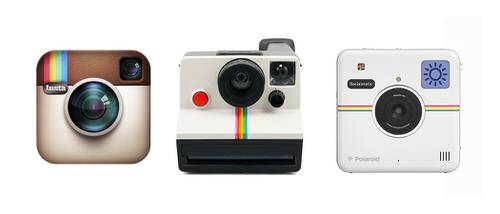
Two years after Italian design firm ADR Studio introduced its concept for one of the most adorable cameras ever, with numerous teases popping up since, the Socialmatic point-and-shooter has finally opened for pre-orders.
A dead ringer for Instagram’s app icon, the chubby, squarish device—which packs its own built-in printer—comes with Polaroid’s branding, a $300 price tag and a ship date of January 1, 2015. The company started promoting the device’s pre-order status on Amazon on Wednesday.
The company officially announced the device back at the Consumer Electronics Show last January. Now, as it heads to the pre-order phase for the holiday season, let’s take a look at this modern version of Polaroid’s classic instant camera.
See also: Polaroid Socialmatic Camera: A Retro Instagram-Style Dream
Not A Serious Camera, But It’s Serious Fun

Despite some suggestion that Socialmatic would vie with Samsung’s Galaxy Camera line, the comparison doesn’t quite work. Both digital cameras run Android software, support wireless (Wi-Fi, Bluetooth), and let users snap and share on the spot. But the Galaxy gadgets offer more serious photography chops, especially the second-generation model.
Simply put, the Galaxy Camera 2’s hardware outclasses the Polaroid. Samsung crammed in more megapixels (16MP vs 14MP), a larger touchscreen (4.8 inches vs 4.5 inches) and more storage (8GB vs 4GB), as well as optical zoom and image stabilization. Hardware specifications for Socialmatic don’t even list zoom, though if it has that at all, it’s likely a digital-only proposition.

But Socialmatic isn’t trying to compete as a serious camera. Think of it as a step up from Polaroid’s previous Z2300 or Z340 digital instant print cameras, though with a much cuter aesthetic and plenty of nostalgia baked in. That embedded ZINK (or Zero Ink) printer recalls the glory days when Polaroid’s instant film cameras turned everyday consumers into photography addicts.
Other products, like Fujifilm’s Instax Mini and Polaroid’s own instant analog cameras, trade on that nostalgic appeal, putting fast, physical photos in people’s hands.

Unlike those products, which uses special film that develops on the fly, Socialmatic requires no film. Its built-in printer doesn’t even require ink. That nifty ZINK printer plants clear dye crystals into 2×3-inch photo paper.
The camera applies a little heat, and the crystals take on color. Presto: photos! But you do need ZINK’s somewhat plasticky photo paper to make it work. In the end, you get smudge-proof, water-resistant, and tear-resistant images to keep or hand pals. As well, of course, as digital image files to upload to your social network of choice.

Earlier prototypes didn’t produce impressive visuals. Then again, classic instant film cameras weren’t known for their quality either, so that may not be a big downside. Given the device’s purpose, the quality could suffice just fine, and the final production model may even improve on it.
If not, the unit still functions as a digital camera capable of sharing directly to your social networks via Android apps. That means people can snap and immediately send to services like Facebook, Twitter, Pinterest and, of course, Instagram, whose app looks like a close cousin of Socialmatic’s outward appearance.
Point, Shoot And Remember Fondly
It’s not quite fair or accurate to imply that Polaroid copied Instagram. After all, the popular photo app and social network obviously borrowed from Polaroid’s aesthetic to begin with.

So in a sense, Socialmatic merely brings this food chain of product development around full circle. Polaroid also extended this charmingly retro design sensibility to its tiny Polaroid Cube HD action camera.
See also: Polaroid Cube: The Cutest Action Camera Yet
Whatever the inspiration or shortcomings of this chunky, flat and perhaps impractically square device, it’s tough not to root for it. This looks like Polaroid’s best bid yet to update its retro brand with modern features, all in a popular product with potentially massive appeal. That’s something the company has desperately needed for years.
Polaroid’s business has been collateral damage in the consumer market’s move to digital photography; the company filed for bankruptcy protection in 2001. Ever since, Polaroid has been trying to find a way to make the most of its fondly remembered brand, dabbling in licensing, new cameras and printers, and other pursuits.
Its long-awaited Socialmatic could be the product to make Polaroids relevant again. The only thing standing in its way: price. During this holiday season, you can get a lot more camera for $300—including the Galaxy Camera 2. It all depends on what price people are willing to pay for a charming nod to the past and wink at the present.
Lead photo courtesy of Polaroid/Socialmatic; classic Polaroid image courtesy of Shutterstock; all others via Amazon

















